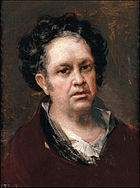- The Second of May 1808
-
The Second of May 1808 (The Charge of the Mamelukes) 
Artist Francisco Goya Year 1814 Type Oil on canvas Dimensions 266 cm × 345 cm (105 in × 136 in) Location Museo del Prado, Madrid The Second of May 1808, also known as The Charge of the Mamelukes, is a painting by the Spanish master Francisco de Goya. It is a companion to the painting The Third of May 1808. The painting depicts a scene during the May 2nd Uprising in Madrid, at the Calle de Alcalá near Puerta del Sol.
Painted in 1814 in the space of two months, today both are displayed in Madrid's Museo del Prado.
Contents
Background
Goya witnessed first hand the French occupation of Spain in 1808, when Napoleon used the pretext of reinforcing his army in Portugal to seize the Spanish throne, leaving his brother Joseph in power. Attempts to remove members of the Spanish royal family from Madrid provoked a widespread rebellion. This popular uprising occurred between the second and third of May 1808, when suppressed by forces under Maréchal Joachim Murat.
The Second of May 1808 depicts the beginning of the uprising when the elite Mamelukes of the French Imperial Guard are ordered to charge and subdue the rioting citizens. The crowd sees the Mamelukes as Moors, provoking an angry response. Instead of dispersing, the crowd turned on the charging Mamelukes, resulting in a ferocious melee.
The painting
Goya was probably not present during the Charge of the Mamelukes. His supposed presence was first suggested in a book published 40 years after his death, reporting on conversations the author claimed to have had with Goya's gardener.[citation needed] His paintings were commissioned in 1814, after the expulsion of Napoleon's army from Spain, by the council governing Spain until the return of Ferdinand VII. He chose to portray the citizens of Madrid as unknown heroes using the crudest of weapons, such as knives to attack a professional, occupying army. That did not please the king (Ferdinand VII) when he returned, so the paintings were not hung publicly until many years (and governments) later.
Goya chose not to paint any single action or to have any single focal point. His dramatically chaotic scene evokes realism or actuality.
Damage
During the Spanish Civil War, when Madrid was bombed by Nationalist troops, the republican government decided to evacuate the paintings from the Prado. A truck carrying Goya's paintings had an accident, and The Second of May was badly damaged: there were tears and even pieces missing. When the painting was later repaired, some damage was left unrepaired at its left border to remind viewers of the events of the civil war.
See also
Sources
- Hughes, Robert. Goya. New York: Alfred A. Knopf, 2004. ISBN 0-3945-8028-1
Francisco Goya Paintings Blind Guitarist (1778) • Christ Crucified (1780) • Maria Teresa de Borbon y Vallabriga (1783) • Spring (or The Flower Girls) (1786–1787) • The Swing (1787) • St Francis Borja at the Deathbed of an Impenitent (1788) • Manuel Osorio de Zuniga (c. 1788) • Witches' Sabbath (1789) • Self-portrait (c. 1790–1795) • Little Giants (1791–1792) • Portrait of Mariana Waldstein (c. 1792) • Strolling Players (1793) • Yard with Lunatics (1793–1794) • Marquesa de la Solana (c. 1794–1795) • Duchess of Alba (1797) • Self-Portrait with Eyeglasses (1797) • The Bewitched Man (1797-1798) • The Devil's Lamp (1797-1798) • Witches' Flight (1797-98) • Charles IV in his Hunting Clothes (1799) • Countess of Chinchon (1800) • La maja desnuda • Charles IV of Spain and His Family (1800–1801) • La maja vestida • Bartolome Sureda y Miserol (c. 1803–1804) • Portrait of Doña Isabel de Porcel (1804–1805) • Portrait of Francisca Sabasa García (1804-1808) • Doña Teresa Sureda (c. 1805) • The Colossus (1808–1812; attribution debated) • Majas on a Balcony (c. 1808–1812) • Time (c. 1810–1812) • Prison Interior (c. 1810–1814) • The Second of May 1808 (1814) • The Third of May 1808 (1814) • The Junta of the Philippines (1815) • The Madhouse (1812-1819) • The Inquisition Tribunal (1812-1819) • The Burial of the Sardine (c. 1816) • A Procession of Flagellants (c. 1816) • The Forge (c. 1817) • The Giant (1818) • Self-portrait with Dr Arrieta (1820) • The Milkmaid of Bordeaux (1825–1827)
Tapestry cartoonsThe Parasol (c. 1777) • Blind man's bluff (1789)Saturn Devouring His Son • Judith and Holofernes • Witches' Sabbath • A Pilgrimage to San Isidro • La Leocadia • Two Old Men • Men Reading • Man Mocked by Two Women • Fight with Cudgels • Procession of the Holy Office • Atropos • Asmodea • Two Old Men Eating Soup • The Dog

Etchings The Sleep of Reason Produces Monsters (1797–1798) • What a sacrifice! (1797–1798) • They say yes and give their hand to the first comer (1797–1798) • Que se la llevaron! (1797–1798) • You who cannot (1797–1798)The Disasters of War
(Los desastres de la guerra)TauromaquiaUnfortunate events in the front seats of the ring of Madrid, and the death of the Mayor of Torrejón (1815–1816)Categories:- 1814 paintings
- Romantic paintings
- Collections of the Museo del Prado
- Francisco Goya paintings
- War art
Wikimedia Foundation. 2010.
